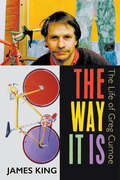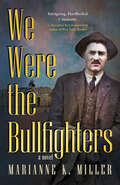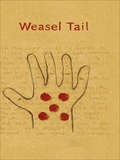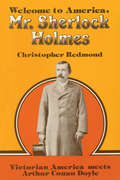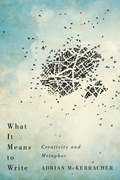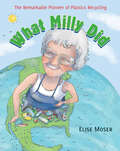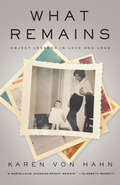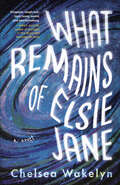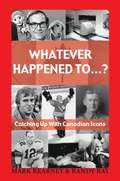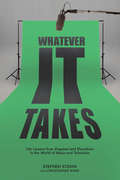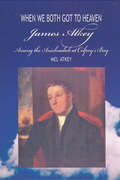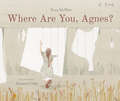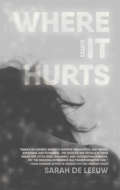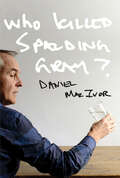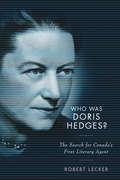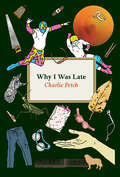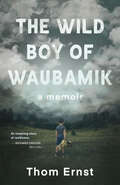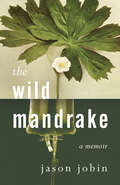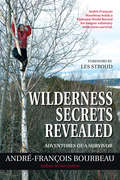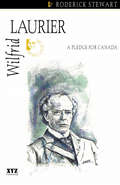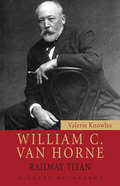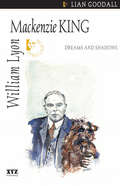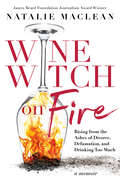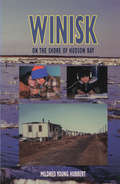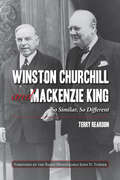- Table View
- List View
The Way It Is: The Life of Greg Curnoe
by James KingThe long-awaited biography of one of Canada’s most intriguing and beguiling artists. Do artists really thrive in big cities, or do they just learn to imitate New York? Is it a contradiction for an artist to be fiercely local and profoundly identified with international art movements? If the brilliant colourist and regionalist pioneer Greg Curnoe stood for any one thing, it was making trouble. An intriguing rebel throughout his life, he challenged ideas about what art should be, and pushed it in radical new directions — including away from Toronto, a city he rejected while succeeding masterfully in its galleries. His untimely death in 1992 cut short a career of constant reinvention. This first biography of Curnoe recaptures in vivid detail the public and personal life of an iconoclast who was called a “walking autobiography,” as his work seemed to document his endless struggle against many of the core tenets of the art of his time. An anti-establishment firebrand and a fierce opponent of American dominance in Canadian culture, Curnoe, in his conceptual practice, constructed a stunning body of work that remains a hallmark in late-twentieth-century Canadian art.
We Were the Bullfighters
by Marianne K. Miller“A window into Canada's role in the making of Ernest Hemingway in clear, clean prose.” — Lee Gowan, author of The Beautiful PlaceSent to cover bank robber Red Ryan’s daring prison break, a young Ernest Hemingway becomes fascinated with the convict.In 1923, Ernest Hemingway, struggling with the responsibilities of marriage and unexpected fatherhood, has just made a big mistake. He decided that for the baby’s first year he would interrupt his fledgling writing career in Paris and move his family to North America. No longer a freelancer, he now has a gruelling job with a difficult boss, as a staff reporter for the Toronto Daily Star. On his first day, already feeling hemmed in by circumstances, he’s sent to cover a prison break at Kingston Pen. The escaped convicts, led by notorious bank robber Norman “Red” Ryan, are on the run, making their way from the bush north of Kingston, to the streets of Toronto, and then through towns and cities across the United States. Their crimes become more brazen, their lifestyle increasingly glamorous. Growing more and more preoccupied with Ryan and his willingness to risk everything to be free, Hemingway ponders duty, freedom, and what stops a man from pursuing his dreams.
Weasel Tail: Stories Told By Joe Crowshoe Sr, A Peigan-blackfoot Elder
by Michael RossPeigan elders Joe and Josephine Crowshoe belonged to a generation still bright with the traditional knowledge and deep memories of their grandparents. They lived under a paternalistic government system that denied them their language, culture, and religion. They reclaimed their heritage and shared it with the larger community, receiving honours for their work and lifetime commitment as articulate representatives of Peigan stories, spirituality, and ceremonial practices. Weaving interviews together with archival photographs and documentation, interviewer Michael Ross tracks not only the life history of Joe and Josephine Crowshoe but also records stories of their culture. Weasel Tail opens a window onto a world and people who form a part of Alberta's history... and future.
Welcome to America, Mr. Sherlock Holmes: Victorian America meets Arthur Conan Doyle
by Christopher RedmondChristopher Redmond’s fascinating account of Doyle’s first trip to America has been reconstructed from newspaper accounts describing the places Doyle visited, from the Adirondacks to New York, Chicago, and Toronto. Despite the gruelling tour schedule, Doyle met dozens of the most important literary and social lights of America. Everywhere he went he was mobbed by public hungry for news of the man he had "killed off" a year earlier — Sherlock Holmes, who was front page news. In Redmond’s lively narrative, which is based on letters, newspaper reports, and other newly unearthed sources, you will discover, as Doyle himself put it, "the romance of America."
What It Means to Write: Creativity and Metaphor
by Adrian McKerracherAt a time when people must work harder than ever to stand out from the crowd, the word creativity can seem vague and overused. But what exactly is creativity? <P><P> Adrian McKerracher travels from Vancouver to Havana to Buenos Aires, leading readers on a journey to discover poignant new insights into a life of letters. Through encounters with artists of all kinds, famous or obscure, McKerracher traces a socio-cultural history of the meaning of writing, each vignette a meditation on the way that metaphor limits and liberates understanding: creativity is a process, a possession, a relation, an algorithm, a game, and more. But What It Means to Write is far more than an archive of the figurative. Along the way, a labyrinth of chance reunites McKerracher with old friends, threatens him with violence, and invites him to remain forever in a place both real and imagined. His journey from cafés to libraries to late-night living rooms embodies the structure of a bold new methodology for interpreting creativity, demonstrating the tools for working productively with ambiguity and rebuilding meaning, one metaphor at a time. <P><P> Told in character-driven narrative pulses that reflect on the nature of belonging, understanding, and loving, What It Means to Write is a celebration of the possibilities of both language and silence.
What Milly Did: The Remarkable Pioneer of Plastics Recycling
by Elise MoserThe extraordinary story of the woman who made plastics recycling possible. Milly Zantow wanted to solve the problem of her town’s full landfill and ended up creating a global recycling standard — the system of numbers you see inside the little triangle on plastics. This is the inspiring story of how she mobilized her community, creating sweeping change to help the environment. On a trip to Japan in 1978, Milly noticed that people were putting little bundles out on the street each morning. They were recycling — something that hadn’t taken hold in North America. When she returned to Sauk City, Wisconsin, she discovered that her town’s landfill was nearing capacity, and that plastic made up a large part of the garbage. No one was recycling plastics. Milly decided to figure out how. She discovered that there are more than seven kinds of plastic, and they can’t be combined for recycling, so she learned how to use various tests to identify them. Then she found a company willing to use recycled plastic, but the plastic would have to be ground up first. Milly and her friend bought a huge industrial grinder and established E-Z Recycling. They worked with local school children and their community, and they helped other communities start their own recycling programs. But Milly knew that the large-scale recycling of plastics would never work unless people could easily identify the seven types. She came up with the idea of placing an identifying number in the little recycling triangle, which has become the international standard. Milly's story is a glimpse into the early days of the recycling movement and shows how, thanks to her determination, hard work and community-building, huge changes took place, spreading rapidly across North America. Correlates to the Common Core State Standards in English Language Arts: CCSS.ELA-LITERACY.RI.3.3 Describe the relationship between a series of historical events, scientific ideas or concepts, or steps in technical procedures in a text, using language that pertains to time, sequence, and cause/effect. CCSS.ELA-LITERACY.RI.4.7 Interpret information presented visually, orally, or quantitatively (e.g., in charts, graphs, diagrams, time lines, animations, or interactive elements on Web pages) and explain how the information contributes to an understanding of the text in which it appears.
What Remains: Object Lessons in Love and Loss
by Karen Von HahnA funny, poignant, and at times heartbreaking memoir about one mother and her love of beautiful objets — and how it ultimately proved destructive.Being left with a strand of even the highest quality milky-white pearls isn’t quite the same thing as pearls of wisdom to live by, as Karen von Hahn reveals in her memoir about her stylish and captivating mother, Susan — a mercurial, grandiose, Guerlain-and-vodka-soaked narcissist whose search for glamour and fulfillment through the acquisition and collection of beautiful things ultimately proved hollow.A tale of growing up in 1970s and 1980s Toronto in the fabulousness of a bourgeois Jew-ish family that valued panache over pragmatism and making a design statement over substance, von Hahn’s recollections of her dramatic and domineering mother are exemplified by the objects she held most dear: from a strand of prized pearls, to a Venetian mirror worthy of the palace of Versailles, to the silver satin sofas that were the epitome of her signature style. She also describes the misunderstandings and sometimes hurt and pain that come with being raised by her stunning, larger-than-life mother who in many ways embodied the flash-and-glam, high-flying, wealth-accumulating generation that gave birth to our modern-day material culture.Alternating between satire and sadness, von Hahn reconstructs the past through a series of exquisitely impressionistic memories, ultimately questioning the value of the things we hold dear and — after her complicated, yet impossible-to-forget mother is gone — what exactly remains.
What Remains of Elsie Jane
by Chelsea Wakelyn“A poignant, laugh-out-loud funny, weird, and heartbreaking window into being bereft and being in love… a striking reminder that there can be beauty in devastation.” — EMILY AUSTIN, author of Everyone in This Room Will Someday Be DeadA heartbreaking and darkly funny portrait of a woman unravelling in the wake of tragedy.Sam is dead, which means that Elsie Jane has just lost the brilliant, sensitive man she planned to grow old with. The early days of grief are a fog of work and single parenting. Too restless to sleep, Elsie pores over Sam’s old love letters, paces her house, and bickers with the ghosts of Sam and her dead parents night after night. As the year unfolds, she develops an obsession with a local murder mystery, attends a series of disastrous internet dates in search of a “replacement soulmate,” and solicits a space-time wizard via Craigslist, convinced he will help her forge a path through the cosmos back to Sam.Examining the ceaseless labour of motherhood, the stigma of death by drug poisoning, and the allure of magical thinking in the wake of tragedy, What Remains of Elsie Jane is a heart-splitting reminder that grief is born from the depths of love.A RARE MACHINES BOOK
Whatever Happened To...?: Catching Up with Canadian Icons
by Mark Kearney Randy RayThe latest book by Canada’s Trivia Guys is an entertaining where-are-they-now look at the fate of some 100 celebrities, newsmakers, and significant artifacts from this country’s past. Lake Ontario swimmer Marilyn Bell, CFL legend Russ Jackson, Canada’s first automobile, and Roger Woodward, a boy who survived the waters of Niagara Falls more than 40 years ago, are among those tracked down. Long after making headlines or burrowing their way into our collective consciousness, these Canadian icons have travelled different roads or in some cases kept more quietly to the path that gained them attention in the first place. Kearney and Ray spice up their stories with dozens of fascinating facts. With website links to further information, this book is a great resource to learn more about Canada’s heritage.
Whatever It Takes: Stories From A Life Behind The Scenes In The Music And Television Worlds
by Stephen Stohn Christopher Ward Martin GeroThis book will change the way you think about success. Producer of television’s iconic Degrassi franchise Stephen Stohn tells stories from behind the scenes and of making it in the music and television world in this star-studded, rock ’n’ roll trip through a Canadian show business explosion. Stohn, who has been at the heart of the entertainment industry for over forty years, shares a lifetime of experience and unique insights into how dreams are turned into reality. “Whatever It Takes” — both a mantra and Degrassi’s theme song — has been heard millions of times all over the world. It embodies a philosophy of struggle and self-belief leading to accomplishment, as well as the story of an exploring mind, an adventurous pursuit of experience, ringing failures, and the willingness to see things in a different way.
When We Both Got to Heaven: James Atkey Among the Anishnabek at Colpoy's Bay
by Mel Atkey Rev Maggie McleodWhen We Both Got to Heaven places James Atkey (1805-1868) on the shores of Georgian Bay at the time of treaty negotiations between the First Nations people of the Saugeen, Nawash and Colpoy’s Bay areas, and the Colonial government. A Methodist lay preacher, Atkey leaves the Isle of Wight and arrives at Colpoy’s Bay with his family in 1855. There he takes up the position of teacher for the Anishnaube children of the area. The great-great-great-grandson of James Atkey, author Mel Atkey engaged in extensive research of both primary and secondary sources. His efforts provide considerable insight into both the influence of Wesleyan Methodism of the time and the background context of the treaty negotiations that ultimately led to the surrender of much of the Saugeen Peninsula for pioneer settlement. People with leadership roles of the past, such as Chief Kegedonce, Kahkewaquonaby (Rev. Peter Jones), Laurence Oliphant and Sir Francis Bond Head, as well as many others, are part of Atkey’s story. Reverend Maggie McLeod of the Cape Croker United Church provides a thoughtful Foreword. This quite remarkable book is a compelling read for those interested in Ontario history, First Nations history, genealogy and the role of religion at the time of European settlement.
Where Are You, Agnes?
by Tessa McWattThis stunning picture-book imagining of artist Agnes Martin’s childhood gives readers a glimpse into the life and work of one of the most esteemed abstract painters of the twentieth century. Agnes Martin was born on the Canadian prairies in the early twentieth century. In this imagining of her childhood from acclaimed author Tessa McWatt, Agnes spends her days surrounded by wheat fields, where her grandfather encourages her to draw what she sees and feels around her: the straight horizon, the feeling of the sun, the movement of birds’ wings and the shapes she sees in the wheat. One day, Agnes’s family moves to a house in a big city. The straight horizon and wheat fields are gone, but Agnes continues to draw what she sees and feels around her. No one except her grandfather understands what she is trying to capture — not her mother, who asks, “Where are you, Agnes?” when she sees her daughter engrossed in her drawing; nor her siblings, who think her art is ugly. Still, Agnes keeps trying to capture what she sees inside her mind. Agnes Martin grew up to become a famous abstract expressionist artist. Tessa McWatt has written a beautiful story of Agnes’s childhood and how it might have shaped her adult work. Zuzanna Celej’s watercolors adeptly capture Agnes’s world, including hints of the grid paintings that she was later known for, against the backdrop of prairie and city landscapes. Includes an author’s note with more information about Agnes Martin’s life and the inspiration behind this story. Key Text Features author's note art history Correlates to the Common Core State Standards in English Language Arts: CCSS.ELA-LITERACY.RL.2.7 Use information gained from the illustrations and words in a print or digital text to demonstrate understanding of its characters, setting, or plot.
Where It Hurts
by Sarah De LeeuwWhere It Hurts is a highly-charged collection of personal essays, haunted by loss, evoking turbulent physical and emotional Canadian landscapes. Sarah de Leeuw's creative non-fiction captures strange inconsistencies and aberrations of human behaviour, urging us to be observant and aware. The essays are wide in scope and exposing what—and who—goes missing.With staggering insight, Sarah de Leeuw reflects on missing geographies and people, including missing women, both those she has know and those whom she will never get to know. The writing is courageously focused, juxtaposing places and things that can be touched and known—emotionally, physically, psychologically—with what has become intangible, unnoticed, or actively ignored. Throughout these essays, de Leeuw's imagistic memories are layered with meaning, providing a survival guide for the present, including a survival that comes with the profound responsibility to bear witness.
Who Killed Spalding Gray?
by Daniel MacIvorSit down, Daniel’s going to tell you a story. On the weekend of January 10, 2004, American monologist Spalding Gray killed himself by jumping off the Staten Island Ferry in New York City. That same weekend, Daniel MacIvor was in California, visiting a psychic surgeon who offered to save his life by removing a spiritual entity that had attached to him. But what if Spalding’s death had something to do with Daniel’s entity? Linking these two true parallel stories is fiction derived from Gray’s obsessions and MacIvor’s inventions about a man named Howard who had forgotten how to live.
Who Was Doris Hedges?: The Search for Canada's First Literary Agent
by Robert LeckerDespite her trailblazing efforts to represent the work of Canadian writers to publishers in North America and abroad, Doris Hedges (1896-1972), the Montreal author who started Canada's first literary agency in 1946, is routinely excluded from Canadian literary histories. In Who Was Doris Hedges? Robert Lecker provides a detailed account of her remarkable career. Hedges published several novels, short stories, and books of poetry, moved in Montreal literary circles, did a stint as a radio broadcaster, and provided reports to the Wartime Information Board during the Second World War, possibly as an American spy. She lived a privileged life in the Golden Square Mile district of downtown Montreal with her husband, Geoffrey Hedges, a member of the Benson and Hedges tobacco empire. The more one uncovers about Hedges's life, the more one discovers a courageous figure who was exploring many of the conflicted issues of her day: the rise of juvenile delinquency, the suppression of female sexuality, the place of women in business and finance, and the difficulties confronting the publishing industry in the years leading up to and following the war. Mixing lively biographical commentary with literary analysis, Who Was Doris Hedges? is a vivid account of a writer's life and concerns during a period when Canada's literature was coming of age.
Why I Was Late
by Charlie PetchWith kitchen-table candour and empathy, Charlie Petch's debut collection of poems offers witness to a decades-long trans/personal coming of age, finding heroes in unexpected places. Why I Was Late fuses text with performance, brings a transmasculine wisdom, humour, and experience to bear upon tailgates, spaceships, and wrestling rings. Fierce, tender, convention re-inventing—Petch works hard. And whether it's as a film union lighting technician, a hospital bed allocator, a Toronto hot dog vendor, or a performer/player of the musical saw, the work is survival. Heroes are found in unexpected places, elevated by both large and small gestures of kindness, accountability and acceptance. No subject—grief, disability, kink, sexuality, gender politics, violence—is off limits. A poet so good at drag they had everyone convinced that they were a woman for the first forty years of their life, Petch has somehow brought the stage and its attendant thrills into the book. Better late than. And better. "Charlie Petch's Why I Was Late is a poetic debut with the wisdom of a sage and the emotional range of an expert comedian. … Do yourself a favor and read this book. This is a master at work."—Kai Cheng Thom, author of I Hope We Choose Love: A Trans Girl's Notes from the End of the World
The Wild Boy of Waubamik: A Memoir
by Thom Ernst“An inspiring story of resilience, told with a vivid sense of character and humour.” —RICHARD CROUSE, CTV host and film criticFilm critic, writer, and broadcaster Thom Ernst chronicles his life growing up with an abusive father in rural Ontario.The residents of Waubamik know about the Wild Boy, a somewhat feral child, standing nearly naked in a rusty playground of weeds and discarded metal, clutching a headless doll. They know the boy has been plucked from poverty and resettled into a middle-class family. But they don’t know that something worse awaits him there.This is the story of a system that failed, a community that looked the other way, and a family that kept silent. It is also a record of the popular culture of the 1960s — a powerful set of myths that kept a boy comforted. But ultimately, The Wild Boy of Waubamik is a story of triumph, of a man who grew up to become a film critic and broadcaster despite his abusive childhood. It reminds us that life, even at its darkest, can surprise us with moments of joy and hope and dreams for the future.
The Wild Mandrake: A Memoir
by Jason JobinOn the cusp of adulthood, a young writer’s life is stalled as he faces cancer that keeps coming back.Doctors used to tell him he was cured. That was a long time ago. Ever since he first left home at age nineteen, writer Jason Jobin has had cancer. Every five years, like clockwork, it relapses, and yet he always pulls through, surrounded by friends and family but isolated by illness. Chemotherapy, surgeries, radiation — these persist, but they aren’t the milestones of his life. They can’t be, he won’t let them be.From helicoptering into the Yukon backcountry to teaching in an elite writing program, Jason strives to enter adulthood with some normalcy, but his is the life of “a special case.” And he does live. He lives working at a deli for minimum wage as his students come down the hill to shop and ask what he’s doing there. He lives measuring out nausea pills and benzos while his roommates drink and smoke and party. He lives lying to girlfriends about past diagnoses because what can you say? What do you build on rubble? He lives high and low and in between. Again he is sick, again he is cured. It’s miraculous. A great gift. But never enough.Told in short glimpses, this story redefines what it means to survive. Jobin brings together the illuminated moments of loss and joy as he navigates chronic illness and builds from it something new and wildly unexpected.
Wilderness Secrets Revealed: Adventures of a Survivor
by André-François Bourbeau Les StroudA lifetime of wilderness adventures and the resulting insights relating to nature’s intricacies as experienced by a master in the art of primitive wilderness survival. "Fire! Wake up! The shelter is on fire!"His students affectionately call him "Doc Survival." He’s Quebec’s Indiana Jones in a forest setting. Searching for the treasures of the wilderness has been his life-long quest; with passion as his only guide, he has dared to penetrate the forest on its own terms, facing increasingly difficult challenges in the hope of becoming nature’s confidant, of learning her secrets.Professor emeritus André-François Bourbeau holds a Guinness World Record for voluntary wilderness survival in the boreal forest. Herein lies his path and his stories, unadulterated: gritty and often comical mistakes punctuated by inspiring successes. What remains of this lifetime of experimentation is one man’s everlasting love of the wilderness and its intricacies, a rousing reflection on our own human priorities, and need for deep connection with the environment and other fellow beings.
Wilfrid Laurier
by Roderick StewartWilfrid Laurier’s life journey took him from a small Quebec village to the Parliament of Canada. He possessed a rare combination of the common touch and political savvy, which he effectively used to remain prime minister of Canada for fifteen years (1896-1911).
William C. Van Horne: Railway Titan
by Valerie KnowlesWilliam C. Van Horne was one of North America’s most accomplished men. Born in Illinois in 1843, Van Horne started working in the railway business at a young age. In 1881 he was lured north to Canada to become general manager of the fledgling Canadian Pacific Ralway. The railroading general pushed through construction of the CPR’s transcontinental line and then went on to become the company’s president. During his time with the CPR, Van Horne developed a telegraph service, launched the Empress line of Pacific steamships in 1891, and founded CP Hotels. He capped his career by opening up Cuba’s interior with a railway. A man of prodigious energy and many talents, he also became Canada’s foremost art collector and one of the country’s leading financiers. For all of his amazing accomplishments, Van Horne was knighted in 1894. When he died church bells throughout the length and breadth of Cuba tolled to mark his passing, and when his funeral train made its way across Canada, all traffic on the CPR system was suspended for five minutes.
William Lyon Mackenzie King: Dreams and Shadows
by Lian GoodallMackenzie King (1874-1950) was Canadas tenth and longest serving prime minister and an important figure on the international scene, especially during the Second World War. This book provides a fascinating glimpse into the world of Mackenzie King.
Wine Witch on Fire: Rising from the Ashes of Divorce, Defamation, and Drinking Too Much
by Natalie MacLeanA powerful memoir about how one woman resurrects her life and career in the glamorous but sexist wine industry.Natalie MacLean, a bestselling wine writer, is shocked when her husband of twenty years, a high-powered CEO, demands a divorce. Then an online mob of rivals comes for her career.Wavering between despair and determination, she must fight for her son, rebuild her career, and salvage her self-worth using her superpowers: heart, humour, and an uncanny ability to pair wine and food.Natalie questions her insider role in the slick marketing that encourages women to drink too much while she battles the wine world’s veiled misogyny. Facing the worst vintage of her life, she reconnects with the vineyards that once brought her joy, the friends who sustain her, and her own belief in second chances.This true coming-of-middle-age story is about transforming your life and finding love along the way.
Winisk: On the Shore of Hudson Bay
by Mildred Young HubbertThe northern community known as Peawanuck (Cree for Flint) is located approximately 32 kilometres up river from the former village of Winisk on the shore of Hudson Bay. There, prior to a devastating flood on May 16, 1986, the First Nations residents of Winisk had carried on with a traditional lifestyle built largely around hunting and trapping seasons.The late Mildred Young Hubbert of Markdale, Ontario, first visited Winisk in the 1960s as a classroom consultant with the then Department of Indian Affairs. Never in her wildest dreams did she imagine the scenario some three years later that found her experiencing an odd sort of honeymoon at Winisk and ultimately her first three years of marriage to the wonderful and highly unorthodox teacher, George Hubbert, all six foot six of him. Together the two teachers came to be a vital part of the village during the mid-1970s, a story lovingly and engagingly told by Millie Hubbert in a manuscript completed just prior to her passing.Winisk: On the Shore of Hudson Bay is charmingly told in the same anecdotal writing style that delighted readers of several previous books by the same author. This is vintage Millie Hubbert!
Winston Churchill and Mackenzie King: So Similar, So Different
by Terry Reardon The Right Honourable John N. TurnerThe story of the complex relationship between two world leaders during one of the greatest crises in human history. Born just two weeks apart in 1874, Winston Churchill and William Lyon Mackenzie King had much in common. Both forged long parliamentary careers, and each led his country to victory in World War II. A BBC poll deemed Winston Churchill the greatest Briton of all time, and Mackenzie King has been judged by a group of historians as the greatest Canadian prime minister. Their parallel careers fostered a working relationship that lasted almost fifty years. It was not always an easy relationship, however. Churchill, famous for his drink and cigars, was impetuous and charismatic, an extrovert; King, a teetotaller during WWII, was noted for considering all options before cautiously proceeding. Fate threw this ill-matched pair together. For the first time, the vital relationship between these two very different men is explored in depth. It is the story not just of two extraordinary leaders, but also of the changing bonds between Britain and Canada.
